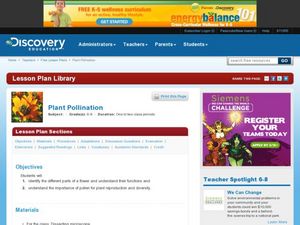Curated OER
Deadly Roots?
Students examine the roots of various plants. They study and discuss the cross section of a root. They compare different plants with their root systems and complete a worksheet, giving the function/importance of each root part.
Curated OER
Animals Piece by Piece
Learners sort organisms and objects into groups according to their parts and describe how the groups are formed.They identify body parts of animals from puzzle pieces, assemble the puzzle, and name the animal.
Curated OER
Plant Pollution
Learners study the different parts of a flower and their functions. In this pollination lesson students study a flower under a microscope.
Curated OER
Leaves and Photosynthesis
For this science worksheet, students read detailed information about green plants and the photosynthesis process. In this fill in the blank and true and false worksheet, students answer twelve questions.
Curated OER
Preparing the Soil
Students explore the concept of philanthropy. In this service learning activity, students read Seedfolks and discuss the characters in the story and consider their actions that led to a community garden. Students journal about their...
Curated OER
Exploring Alaska Foilage In Russian
Seventh graders investigate the concepts of how plants are part of daily culture in Russia. The skills of naming different plants is practiced. Students take a survey of the nature that is found in the area in which they live. This is...
Curated OER
Grow a Plant
Young scholars combine their prior knowledge about plants with a garden learning activity. In this science gardening lesson, students discuss what plants need to survive. Young scholars then plant a seed themselves and demonstrate...
Curated OER
Pollen Tracks
Learners participate in an artificial dig investigating imitiation rock samples that contain "pollen" from ancient plants. Students determine which plants the pollen samples came from.
Curated OER
Mythical Animals
Students create imaginary animals by assembling pictures of body parts from pictures of real animals. This is one of three linked tasks. The others are "Who's Parts Do I Have?" and "Animals Piece by Piece."
Curated OER
Biomes -- Part 1
Students use the internet to locate and gather information on the world's biomes. They compare and contrast biomes to ecosystems and describe the human effects on ecosystems. They answer questions to end the lesson.
Curated OER
Death and Recovery
Mount St. Helens erupted on May 18, 1980, devastating plant and animal life for miles around. Two activities are included in this lesson plan. In one, learners evaluate tree rings to determine the age of a tree and the year of a volcano....
PBS
Reading Adventure Pack: Bees
A Reading Adventure pack explores the busy life of bees. After reading a fiction and nonfiction text, scholars complete three hands-on activities. Participants invent a robot that can do the work of bees, cheers to hardworking bees with...
Great Schools
Letter of Complaint
If you've ever received bad service or disagreed with a company's decision, writing a letter of complaint might be a good skill to have. Review the format of a letter, author's purpose, and other aspects of persuasive writing with an...
Nuffield Foundation
Interpreting an Investigation of Plant Hormones
How important is the tip of a new shoot on a growing plant? Individuals learn about the results of experiments on shoot tips and must interpret them. They apply previous learning and connect complex ideas through advanced analysis.
Curated OER
Photo Synthesis and Transpiration
Middle schoolers germinate pea seeds and plant the seeds. They experiment with different amounts of light and darkness on the plant growth.
Curated OER
Alfalfa Butterfly/Caterpillar Lifecycle Investigation
Students collect and record data. They identify sex of butterflies. They make conclusions based on collected data.
Virginia Department of Education
Cell Parts
What do a bird, an egg, a rabbit, and a toad all have in common? This fun-filled resource explains the similarities and differences between cells and how all cells are similar, yet all are different. Learners begin by depicting a...
Curated OER
Plant Growth
Students explore the parts of a plant and seed. They plant seeds and observe the growth of plants. Students record the observations. They discuss and share the observations they see.
Curated OER
Plant Growth and Environment
Third graders bring to school various green plants and categorize them into plant leaves, stems, roots, and fruits. They answer the question, "How can you show there is starch in a plant?" and perform the iodine test and describe the...
Curated OER
Munching Insects
Students design an experiment to discover what types of plants particular insects prefer. They comprehend that insects eat only specific plants and that this has particular implications for noxious weeds. Students observe and collect...
Curated OER
Finding and Collecting in the Field
Learners examine the types of plants brought over to America from immigrants. They research how some of these types of plants cause damage and alter the landscape. They record data and share the information with the community.
Curated OER
The Compost Bucket
Learners recognize that plants and soils have a close relationship. They view a photo essay on the common practice and natural process of composting. Afterwards, they observe the process of plant decay over the course of several days.
Curated OER
Wappo Indian Baskets
Third graders research the basket-making skills of the Wappo tribe and their other uses of plants. They compare Wappo designs and plant use with those of other tribes. They explore their neighborhoods for plants to make baskets.
Curated OER
Tagging Race
Students examine and identify plant parts to recognize specific weeds, identify three different weeds, discern differences in weeds quickly, evaluate classmates' weed recognition, and discuss what strategies they used to identify weeds.























